
A flock of Doves takes detailed pictures of the whole Earth every day. You’ve probably seen their photos, or read a headline informed by the data they gather. What can the Army learn from these birds and the former NASA engineers who set them aloft?
by Mr. Michael Bold
As wildfires raged through half a dozen Northern California counties in October, a San Francisco company offered free access to its satellite photos of the devastation to the public, first responders, aid providers and media.
What made the company’s photos of the burning wine country worth studying was that they were taken daily from 230 to 310 miles above Earth. The company, Planet, operates the largest constellation of satellites ever—more than 190 at last count.
Planet’s story began in 2010, when three aerospace engineers left the NASA Ames Research Center in Mountain View, California, to start an audacious business: a private satellite company.
The trio—American Robbie Schingler, Briton Will Marshall and Australian Chris Boshuizen—built their first prototype satellites in Schingler’s garage, basically taking apart a cellphone and adding a telescope, extra battery power and some other features. They moved their lab to San Francisco in 2011 and founded Planet Labs Inc., now known simply as Planet. (Boshuizen left the company in 2015.)
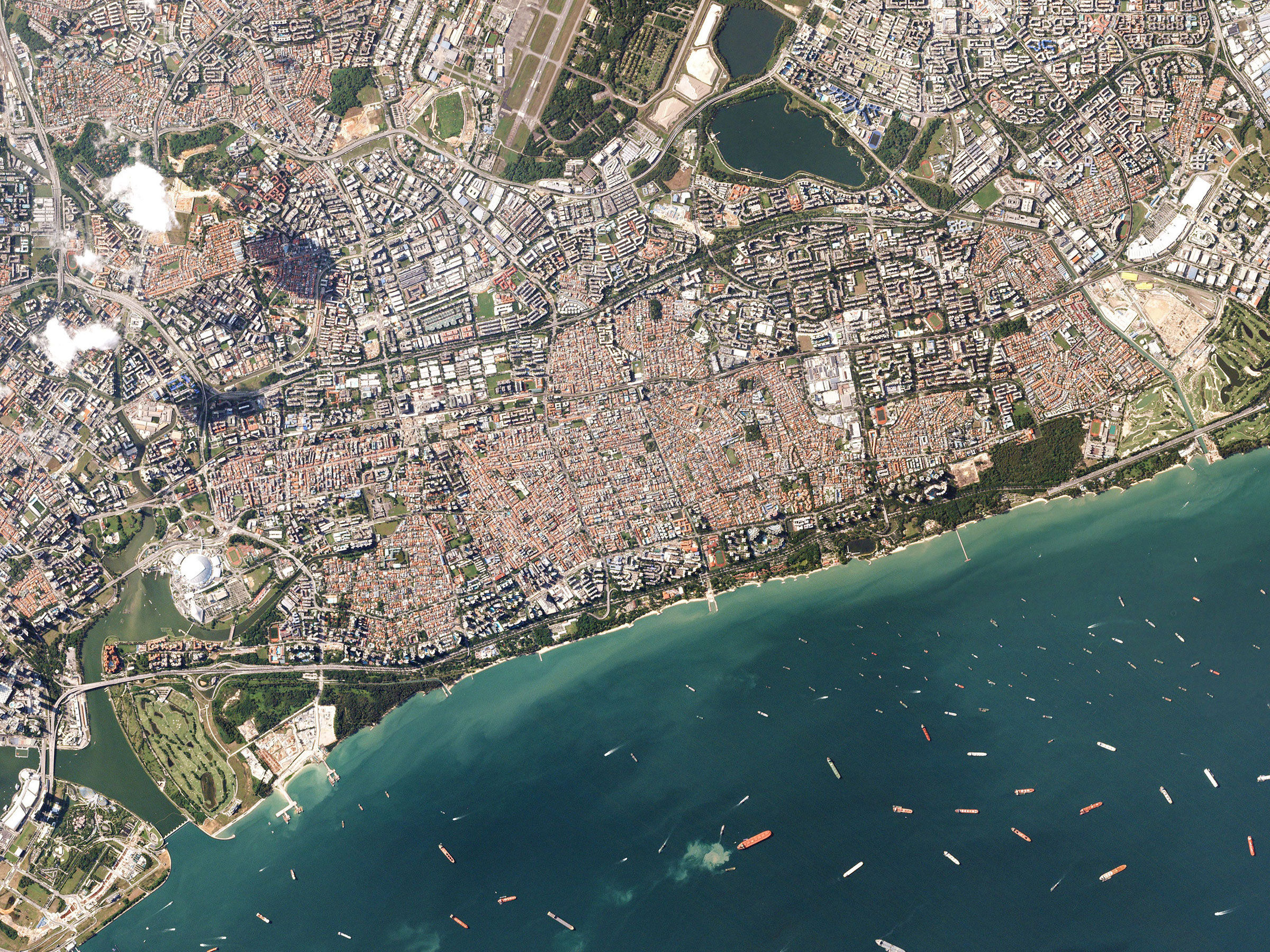
SINGAPORE STRAIT
A ship leaves or arrives in the Port of Singapore every three minutes. Keeping the congested waters off the port safe while keeping tabs on what passes through is a tall order. Recurrent images of the port help, but using human eyes to inspect the images is time-consuming and difficult. Programming image software to count ships in seconds unlocks more possible uses for the data; Planet develops some tools like this, and outside companies also contract with Planet customers to analyze image data algorithmically.
Their idea was revolutionary. Satellites typically weigh over 3 tons and are about the size of a bus, take a decade or more to design and build and, by the time they’re deployed, are running on obsolete computing systems for the 10 or so years they’re in use. What Planet does is turn all that on its head. Each of their satellites (called Doves, and launched in Flocks) is roughly the size of a large shoebox and is built using commercial off-the-shelf technology.
They’re constantly being upgraded with the latest available technology (the Dove is on its 14th iteration) for the roughly three years they’ll be in orbit. They take continuous daily photographs of Earth. The difference between their images and, say, Google Earth’s is that Planet’s images are updated daily, rather than every few months, and are compiled into a cloud-based database, allowing users to compare changes to areas both large and small over time.

A LITERAL GOLD MINE
This open-pit mine in Kokpatas, Uzbekistan, operated by Navoi Mining and Metallurgical Combinat, a state-owned company, began operating in the mid-1990s and has been expanding ever since. “We are a commercial-first company,” Schingler stresses, primarily interested in helping customers make better business decisions. But Planet believes its imagery can also contribute to better stewardship of the world’s resources, and its images are useful to organizations monitoring conflict and humanitarian situations and regulating natural resource extraction. (Images courtesy of Planet)
The satellites, as Planet describes it, “act like a line scanner for the planet.” Custom automation software allows Planet’s Mission Control team to schedule imaging windows, push new software in-orbit and download images to 30 ground stations worldwide. The constellation of 190-plus satellites is akin to what the Army foresees as it pursues networked swarms.
But it’s once all those images get back to Earth that the real magic begins. Planet has developed analytical algorithms that produce an array of products for:
Agriculture—Planet’s continuous images of their fields allow farmers to understand changes in soil, crops, irrigation and disease, allowing them to farm more efficiently, profitably and sustainably.
Governments—Planet’s imagery lets local governments track urban growth, unpermitted building and changing land use, and allows them to better manage regional transportation budgets, land use policy, economic development plans, disaster response, crisis management and humanitarian aid, such as in the case of the Northern California fires and Hurricanes Harvey and Irma.
Intelligence and defense—Planet provides transparency into global events, constantly photographing broad swaths of Earth and targeted areas of interest. The images allow for monitoring of man-made and natural disasters; ports and shipping; and population shifts. Planet’s images after the recent North Korean nuclear test showed widespread landslides in the area surrounding the test site, suggesting to experts that the explosion was much larger than originally thought.
Forestry—Images allow for improved monitoring of forest health, tracking of illegal logging and planning of timber-harvesting operations.
Planet also offers products for mapping; energy and infrastructure; and finance and business intelligence.
Other companies, known as analytics-as-a-service companies, use their own algorithms to sort Planet’s data, and many of them, in turn, have partnered with Planet. A Jakarta-based analytics company, Dattabot, used satellite data from Planet to help secure loans for Indonesian farmers.
Planet is at the leading edge of an exploding wave of space privatization, its satellites having hitched rides on U.S., Indian, Russian and private rocket launches. Planet and other satellite startups, including UrtheCast Corp., DigitalGlobe Inc. and Orbital Insight, are making Earth-imaging resources once reserved for governments available to businesses and the public. Companies such as Elon Musk’s SpaceX, Orbital Sciences Corp. and Blue Origin, owned by Amazon founder Jeff Bezos, are launching their own rockets into space.
Planet’s medium-resolution Dove satellites (in the aerospace industry, satellites are commonly called “birds”) got the name because they are “peace-bringing satellites, enabling commercial, humanitarian, and environmental applications at a scale that has never been attempted before,” according to the company website. As of October 2017, there were more than 175 of them circling the Earth. In a single launch in February, Planet sent 88 satellites aboard an Indian rocket into orbit. Another 48 were launched in July aboard a Russian Soyuz rocket.
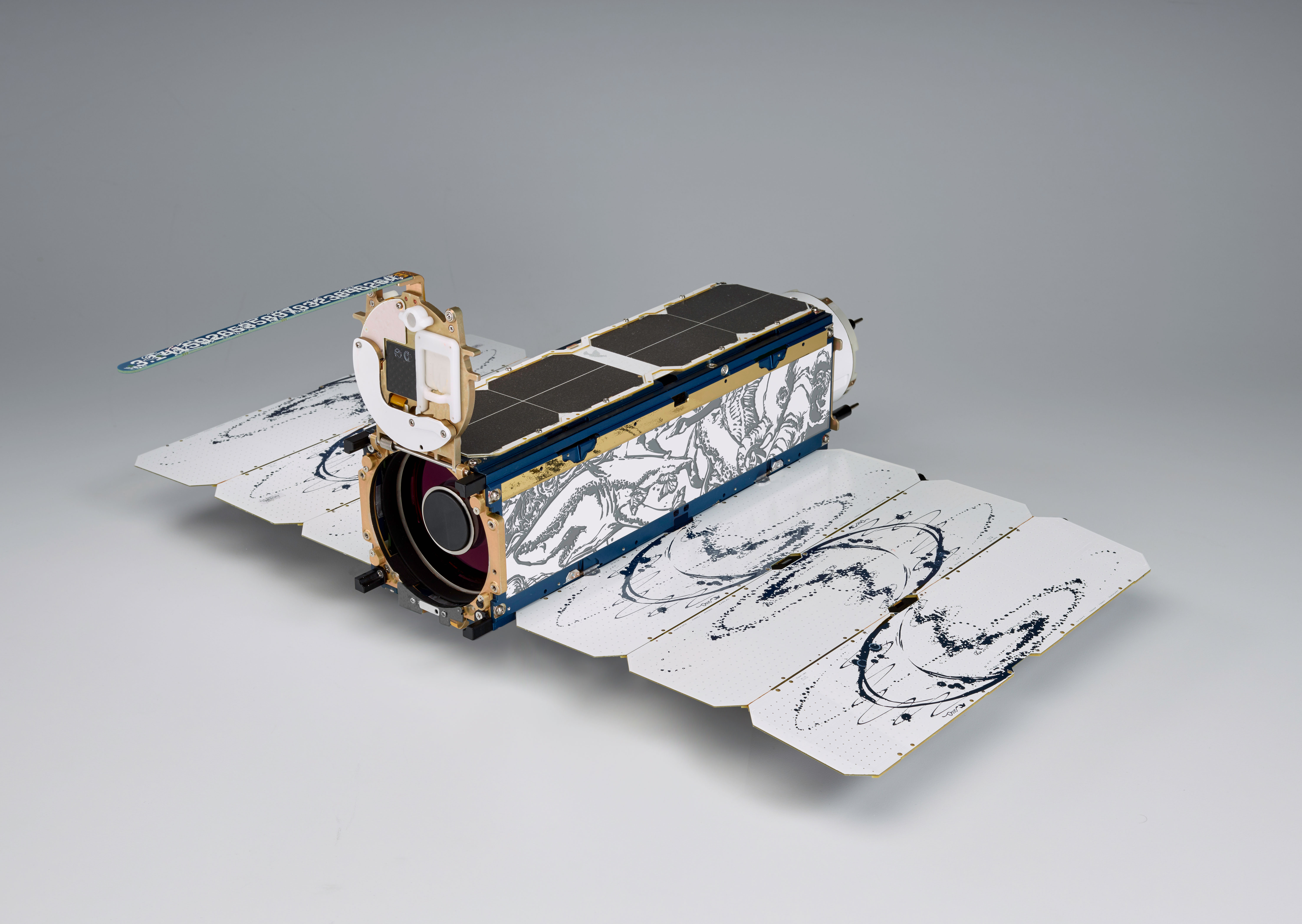
BE AWED, BUT NOT OVERAWED
Among other benefits, the smaller size of Planet’s Dove satellites—about as big as a loaf of bread—brings the satellite down “off the pedestal,” in Schingler’s words, letting engineers see the whole system instead of just the subsystem they work on and think more critically about what it can do.
Also in Planet’s constellation are five medium-resolution RapidEye satellites, acquired when it bought BlackBridge in 2015; seven high-resolution SkySat satellites acquired when Google sold its Terra Bella subsidiary to Planet in February 2017 (as part of which, Google acquired an equity stake in Planet and entered into a multiyear agreement to purchase SkySat imaging data); and six SkySats launched in October.
Not that the private satellite business is without its risks. In October 2014, an Orbital Sciences Antares rocket, whose payload included 26 Doves bound for release from the International Space Station, exploded shortly after launch off the coast of Virginia. In June 2015, a SpaceX Falcon 9 rocket broke up during takeoff from Cape Canaveral in Florida; eight Doves were aboard.
While Planet is most definitely a business—according to a Bloomberg Business article from June 29, 2017, Planet has raised more than $180 million in venture capital and is valued at more than $1 billion—it sees its mission as making the world a better place by changing the way we understand, and ultimately manage, the Earth’s resources. “Whether you’re measuring agricultural yields, monitoring natural resources or aiding first responders after natural disasters,” says its website, “our data is here to lend businesses and humanitarian organizations a helping hand. Planet believes timely, global imagery will empower informed, deliberate and meaningful stewardship of our planet.”
Schingler, 38, Planet’s co-founder and chief strategy officer, spoke with Army AL&T on Oct. 11, 2017. He worked for 10 years at NASA, where he helped build the Small Spacecraft Office at NASA Ames and pursued new business opportunities for the Transiting Exoplanet Survey Satellite, a planned space telescope that’s part of NASA’s Explorers Program.
Schingler later served as NASA’s open government representative to the White House and as chief of staff for the Office of the Chief Technologist at NASA. He received an MBA from Georgetown University, an M.S. in space studies from the International Space University of Strasbourg, France, and a B.S. in engineering physics from Santa Clara University. He was a 2005 Presidential Management Fellow.
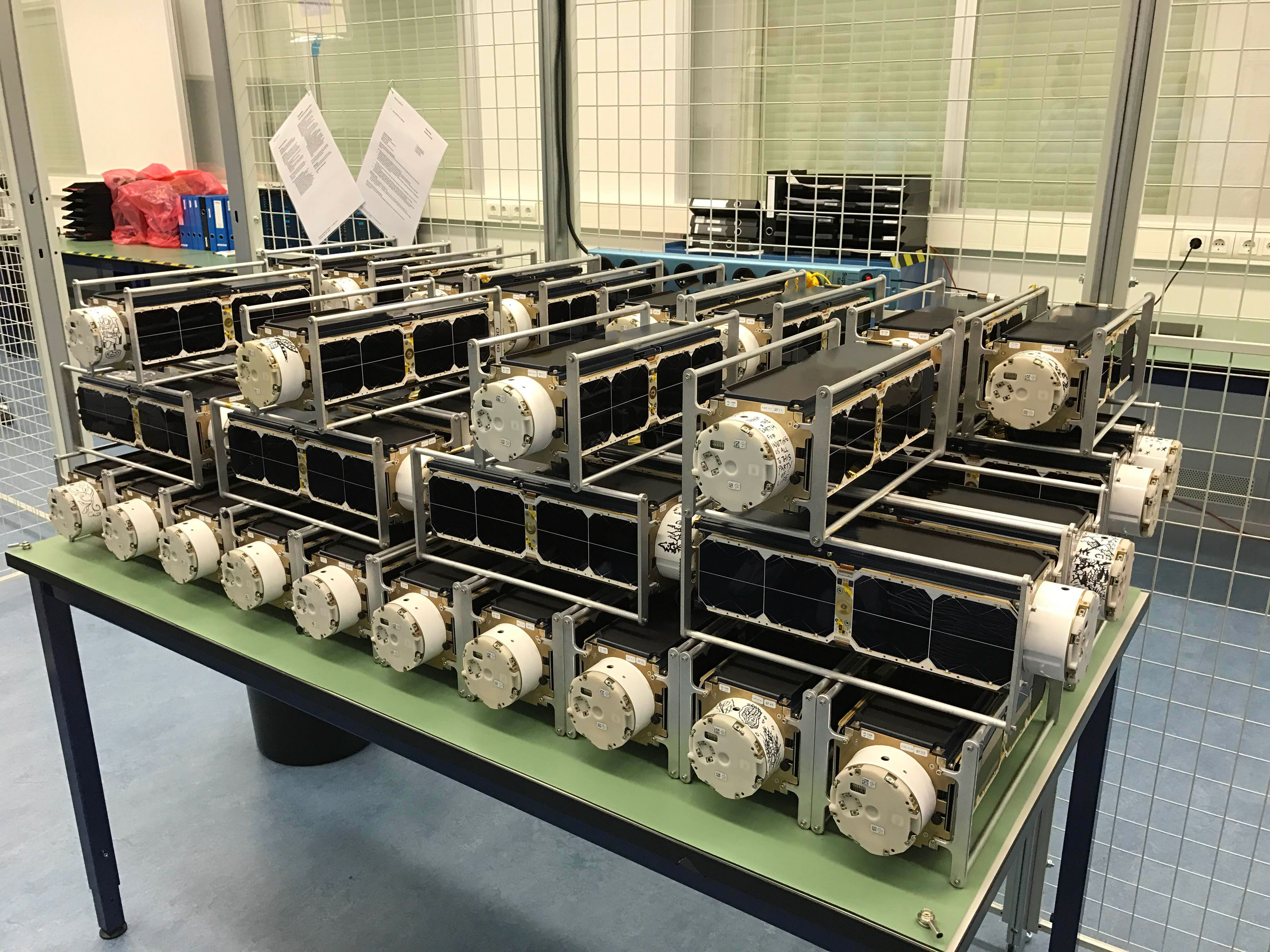
FROM LAB TO LAUNCH
Forty-eight of Planet’s Dove satellites—known as Flock 2K—are prepped for launch. Launch prep includes planning for possible failure: Planet lost 26 satellites when the rocket they were attached to blew up on the launch pad. Planet owns satellites, but not rockets, so the company has negotiated with India, Russia, the U.S. and private companies launching their own rockets, to send Doves into space.
Army AL&T: Planet Labs can photograph nearly all of the Earth’s surface every day, which is something not even the U.S. government can do. To what purpose?
Schingler: The purpose for us is to do a global monitoring mission at this spatial resolution [how small an object you can see]. So that’s important. … Actually, just to correct you, the U.S. government is mapping the whole Earth every day with the MODIS satellite, which is 500 meters per pixel. One satellite. But what we do is image the whole world every day at 3 meters per pixel. And that spatial resolution allows for us to build a data set that lends itself to analytics. So when you apply the analytics technology to this data, you can come up with some really interesting insights.
We are a commercial-first company—we have a lot of customers in agriculture and in finance sectors, and they’re interested in making a better decision on either a trade or when to plant and cultivate. And [with] the spatial resolution and the temporal resolution [the precision of a measurement with respect to time] that we have, they’re able to measure economic stops and flows on the planet.
Now, it turns out from a government perspective … the same pixels and the same analytical capabilities can be used to modify our government’s workflow as well, on the civil side and on the military intelligence side. On the military intelligence side, the time-series nature of this—the term of art has been “activity-based intelligence,” or patterns of life. … When you can classify that change, that pattern of life, and identify a signature that then can become an early indication of something about to happen, then you can better allocate your scarce resources—either high-resolution capabilities, pixelated aircraft or human—in order to then anticipate what’s about to happen and, in some cases, mitigate something from happening.
Army AL&T: You guys made it big by going small, by building not only very small satellites but a lot of them. Is there a lesson for DOD and the Army about going small, and about using off-the-shelf technology?
Schingler: Absolutely. I believe that the future of space is to continue to have very, very high value, unique, one-of-a-kind assets—whether they’re flagship astrophysics missions or they’re used for national technical needs. When it comes to things that are a bit more operational, that have commercial utility, I think the Army and the government in general should be really adoptive, should embrace these newer technologies and allow for [the government] to then, on the space side of things, focus on the harder things, and focus further out. Something that gives them an offset.
Now, lessons specific for the Army, around using small satellites, is just: Get on with it. You know, this is actually a really, really good training capability for young [engineers]. Give them the ability to innovate within a box, you know, whether it’s size or whether it’s cost or whether it’s time, or all three, and see what they can do. By treating the satellite like a robot, which is what it is, rather than something up on a pedestal—that maybe you influence one appliance or one component within one subsystem within one mega-satellite over a decade—you have a different relationship with it as an engineer.
And so by iterating on that relatively quickly, you really understand the system dynamics of the hardware, which then allows you to think about the system dynamics of the entire system. It’s not just the sensors that you launch into space, but you think about the entire value chain. Ultimately, the reason why we’re going into space is to collect unique information—and, with that unique information, to allow for people to make better decisions. … We also go to space for other signals like PNT [positioning, navigation and timing], and for [communications], but largely for all the other applications, it’s really about getting unique information to make better decisions.
So the faster that we can speed that up, from asking a question to getting an answer … is really smart. There are places to innovate—not just on the hardware that goes into space but on the network of the ground stations. Then also the data exploitation platform that allows for an end user to ask a question and get an answer.
What’s very interesting about this trend of small satellites that would interest your readers in the Army, and the growing proliferation of unclassified and commercial imagery we see, is that users that want to use this … more tactically rather than strategically, can now get access to space. And so that’s one of the beauties of our constellation [of satellites’] capabilities. By remaining unclassified, it means that you don’t have to have four stars on your shoulder to get access to what was once an extremely strategic capability. It now can be done in more of a day-to-day operational modality.
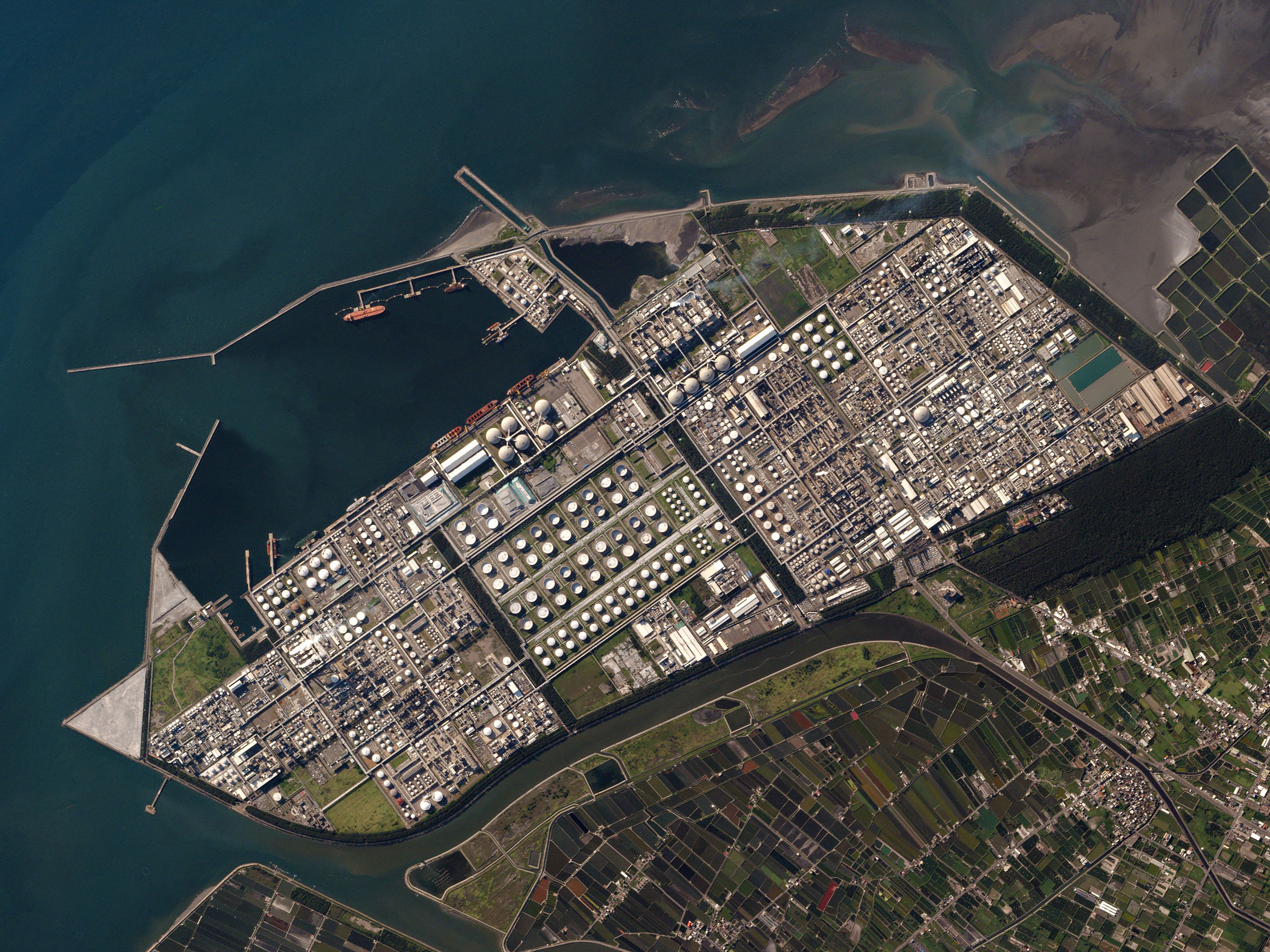
IMAGES AS DATA
Tankers unload crude oil and take on refined products at the sprawling Mailiao Refinery in Taiwan in May 2016. Satellite pictures like this one are just part of what Planet sells to customers; the rest of the package is analysis of the data drawn from the images. Planet has developed specialized analytics for energy companies, agriculture, financial services, forestry and other fields.
Army AL&T: The satellites get all the attention, and rightly so. They’re very sexy. But what about the analysis of that data? The possibilities seem to be almost limitless. And in fact, you’re partnering with a number of companies that take your data and analyze it differently than you do. Talk about that.
Schingler: OK, that’s a great question. And I’m glad that you brought up a number of our partners and customers, because it’s absolutely key for this to really grow the market and allow for something, again, that was once strategic use for government to actually make its way into better decision-making tools in the economy. And that’s what we’re absolutely focused on doing, growing the number of users who can get access to this information.
Our industry, remote sensing, is a very special theme-strategic industry that was primarily driven by the intelligence community for decades. And we called it the tradecraft, being able to exploit … and promote remote-sensing information. You know, you had to have a master’s and a Ph.D. in order to understand what you were looking at. I think what has evolved over time is [that] the IT [information technology] companies of the world have really commoditized … cloud-based technology. And that begins to open-source a variety of computer-vision and machine-learning algorithms. And machine-learning algorithms need data. They need data in order to actually train those algorithms so that they become more accurate.
So at Planet, we see ourselves as collecting unique information and bringing that unique information with other spatially explicit information to analytics. When you add data plus analytics, that’s really what our product is, it’s a platform that has core machine-learning analytics baked into it.
We’re trying to decrease the barrier for our users to ask questions and get answers. In order to do that, we partner with a variety of companies that have access to our data and core analytics in order to allow for them to build a product that focuses on the customers’ needs.
You know, we have customers that are building applications specific for farmers or specific for a commodity trader or that is specific for an insurance provider or for a small holder in agriculture capability. We have hundreds of customers. Our customers operate in over 100 different countries and are really focused on actually building businesses, building a product that can scale and that will really solve the problem. So we see ourselves as more of a platform and an enabler that allows for people to come up with new products and services that were not possible before. Because we’re doing a lot of the hard-core remote sensing work to get all of that data co-registered, co-aligned, activated to the cloud, then also with the core machine-learning analytics that allow for our users and customers to build novel products and solutions. So that’s the reason why we partner with a lot of people that actually are building applications that are derived from Earth observation data.
Another program, I think, that’s really specific and useful for the Army and the government in general is that we are an unclassified and commercial company. And there are many workflows and use cases that we aren’t aware of that the government has and truly needs. So we have a partner program for system integrators and for companies that exist to help the government solve their problems. And they are able to take this new commercial tool and then customize elements of it so that they can modernize internal workflow within the U.S. government. That’s something that I think is just beginning. It takes quite a bit of time in order to modify a workflow. By blending in some automation, you can really increase the ROI [return on investment] of the people and the assets that are already deployed to solve government needs.
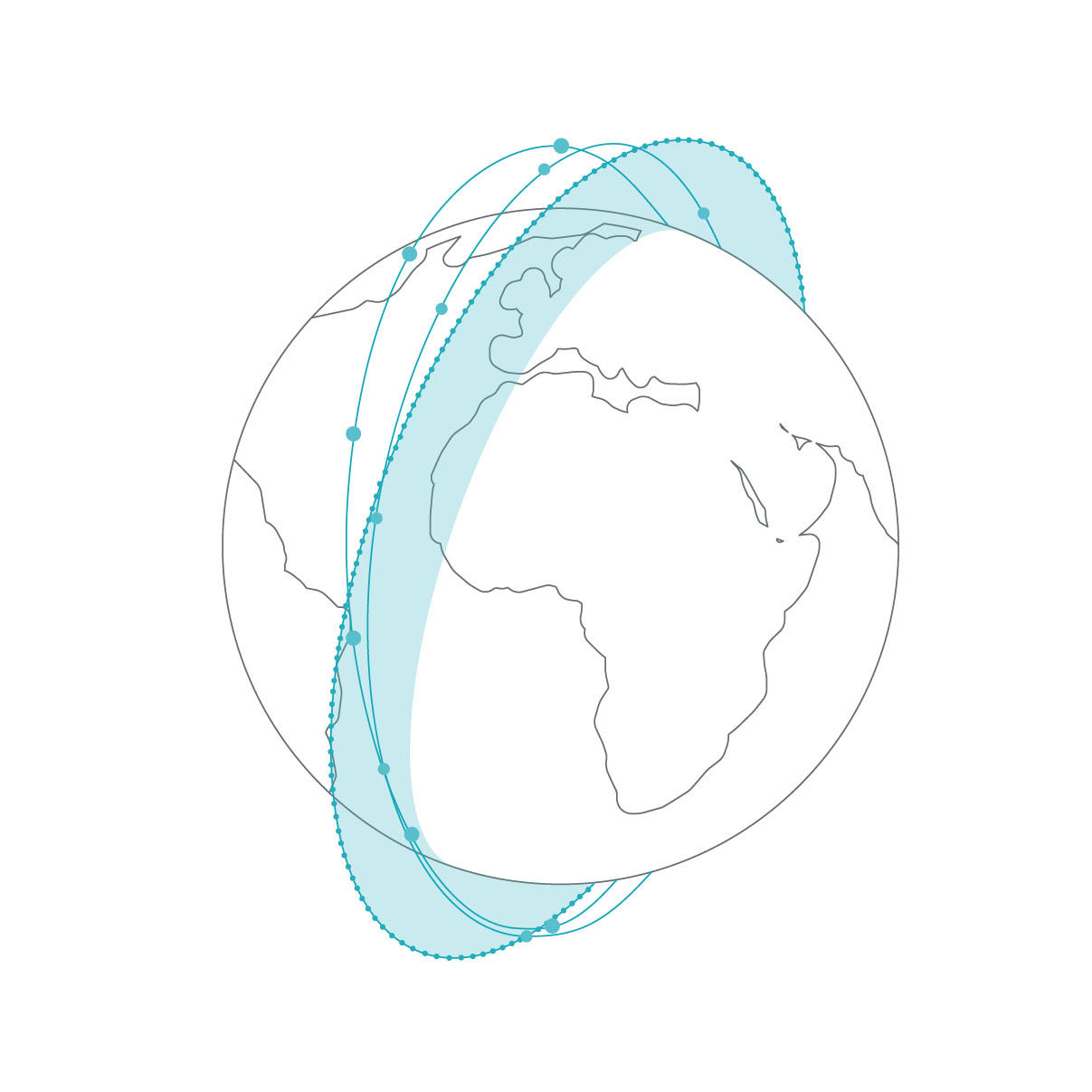
COVERAGE PLAN
Satellites in Planet’s constellation are spaced out in lines around Earth, to photograph the whole planet, every day. Each one orbits the poles every 90 minutes.
Army AL&T: I wonder if you could talk for a minute about failure. It seems like a certain amount of failure is built into your business plan. You’ve lost satellites when rockets exploded on the launch pad. Your satellites have a life span of about three years, but you’re constantly tinkering and upgrading and changing.
Schingler: We test, learn and iterate on our technology constantly, whether it’s a new sensor or a new technology in space, or whether it’s how we manufacture our satellites or how we build out our ground stations or build out our automated mission control and our data pipeline and our analytics. We abide by the popular principle of a highly aligned and loosely coupled organization. That allows for each of those nodes to be constantly upgraded over time. That then ends up increasing the value that comes out in the end for the user and for the customer. That’s how we actually develop the technology.
The way that we operate the technology is to be reliable, because what comes out in the end is we want to have a service-level agreement that we can live up to and that our customers can expect. And so those two things, being agile and being reliable, are two values that we have in the company. You can’t really have one without the other if you want to keep inventing new technology. But then you also want to anchor in that type [of] project in the world, in the market.
That same methodology fits all those in the company: We really wanted to be able to build satellites in a very different way and to iterate on the learnings of the technology and to pull into the satellite new chips and components when they just come out on the market. And knowing specifics in space, you can take those chips and components and actually build out a system that can then work well in space today.
We have a very, very robust, high-performing satellite in a 5-kilogram package. Part of the reason we wanted to go small, too, is so the launch costs are less per satellite. If the launch costs are less per satellite, then the total cost of the system is less. If the total cost of the system is less, then if you lose one or two or three [satellites], that’s part of doing business. But if you lose one or two or three, then that means that you’ll take a bigger step with the new technology that you develop. And so by taking a bigger step, that means that you actually are bringing the future forward even faster. You can see how that’s a positive feedback for accepting risk, and reasonable risk.
That being said, you know, when we launched 88 satellites, that’s kind of putting a lot of eggs in one basket. And so, of course, we accepted that risk but we hedge it by buying insurance. There are ways that you make sure that these things aren’t catastrophic for the organization.
I think that’s the main thing, is you don’t ever want to have an existential thing that’s out of your control actually impact the viability of an organization. And so in space, we always want to launch more than we need so that we can basically degrade [as satellites go offline].
Army AL&T: Is there anywhere you would draw the line in terms of working with the government?
Schingler: Planet is a commercial organization. We see the federal market as the largest market in geospatial today. And so we definitely need to service that market by selling a commercial service to them. But that’s very different from going inside the government and being a systems integrator or being a contractor. Our reason for being is to bring global change to the enterprise and to bring geospatial into a workflow of business at the speed of business. That’s how we’ve chosen to focus, and it’s different from going inside to the government and being one custom solution for a very, very large, important problem. But the ecosystem is much larger than that. So we’re purposefully selling the same thing to the federal government that we would sell to an agriculture company or to a financial data services company.
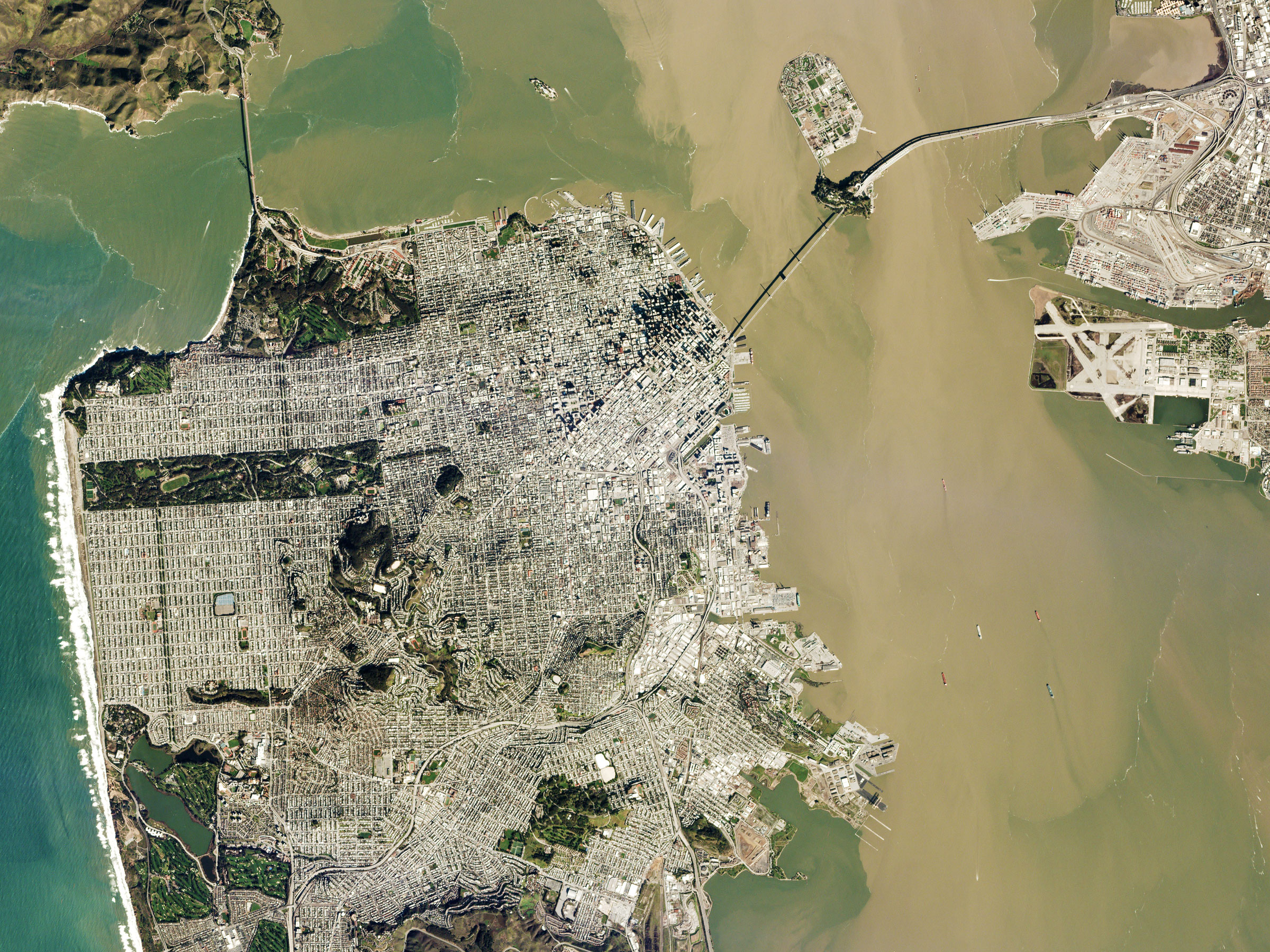
LA NINA’S EFFECTS
On a rare clear February day during California’s rainy 2017 winter, a satellite snapped this picture of Planet’s San Francisco headquarters. It shows not only the Golden Gate Bridge, top left, but also the sediment washed by rains from the 4,600 square miles of the watershed muddying the San Francisco Bay. A scientist measuring how water quality changes as runoff increases could supplement data from water samples with satellite imagery from the same days—since Planet re-images the entire planet every day—to develop a broader understanding of the daily impact of sediment.
Army AL&T: You worked for the government, for NASA.
Schingler: Yeah, for 10 years.
Army AL&T: What, if you were put in charge of NASA tomorrow, would you change?
Schingler: I would invest in small launch, number one. Number two is I would do procurement reform in order to allow for the government to be a good customer, rather than only seeing industry as being a contractor. And number three is I would have a portfolio of projects that allows for my creative engineers and younger engineers to prototype and integrate and invent new technologies for government-specific needs.
Army AL&T: Is there anything you would like to add?
Schingler: I actually want to highlight what this is going to mean for the Army mission. You guys have a global mission. And a lot of it is used to keep the peace. And many missions today are done with collaboration, with our allies. And one of the unique things that really comes out of this commercial space revolution, and coming up with these unclassified data sources, means that you could get data just as fast. The person in the field can get it and share it and collaborate with an allied partner at the same rate that the intelligence community gets it or that the strategic community gets it.
So this is a game changer. It allows for people to have fresh, unique information. It’s unclassified and shareable, so you can come up with interesting and custom workflows. And it means that it speeds up the decision-making process. So the people on the ground will have greater situational awareness and understand what’s about to happen probabilistically. So I really do encourage your leaders to take stock of the direction where this is going, because it really is going to, I think, change the day-to-day workflow of people in the field.
MR. MICHAEL BOLD provides contract support to the U.S. Army Acquisition Support Center. He is a writer and editor for Network Runners Inc., with more than 30 years of editing experience at newspapers, including the McClatchy Washington Bureau, The Sacramento Bee, the San Jose Mercury News, the Dallas Morning News and the Fort Worth Star-Telegram. He holds a B.J. in journalism from the University of Missouri.
Related links:
Planet: https://www.planet.com/
Robbie Schingler, for TheUNGlobalCompact’s Project Breakthrough: https://www.youtube.com/watch?v=0p0qTHM9wA4
Will Marshall’s TED Talk: https://www.youtube.com/watch?v=UHkEbemburs
Planet images of Northern California wildfires: https://www.planet.com/pulse/northern-california-wildfire-satellite-data-available-for-access/
Subscribe to Army AL&T News, the premier online news source for the Acquisition, Logistics, and Technology (AL&T) Workforce.







